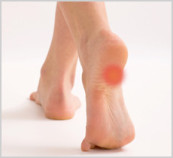
Heel Pain
What causes heel pain?
Heel pain is generally the result of faulty biomechanics (walking gait abnormalities) which place too much stress on the heel bone and the soft tissues that attach to it. The stress may also result from injury, or a bruise incurred while walking, running, or jumping on hard surfaces; wearing poorly constructed footwear; or being overweight. However, heel pain can be the result of a stress fracture, which requires different treatment. We can determine the appropriate treatment based on examination and imaging with x-rays, CT scan, and/or MRI.
Heel Spurs
A common indicator* of heel pain is the heel spur, a bony growth on the bottom of the heel bone. The spur, visable by X-ray, appears as a protrusion that can extend forward as much as half an inch. When there is no indication of bone enlargement, the condition is sometimes referred to as "heel spur syndrome."
Heel spurs result from strain on the muscles of the foot, by stretching of the long band of tissue that connects the heel and the ball of the foot, and by repeated tearing away of the lining or membrane that covers the heel bone. These conditions may result from biomechanical imbalance, running or jogging, improperly fitted or excessively worn shoes, or obesity.
*While the spur itself usually does not cause pain, it is a good indicator of Plantar Fasciitis (see below).
Plantar Fasciitis
Both heel pain and heel spurs are frequently associated with an inflammation of the band of fibrous connective tissue (fascia) running along the bottom (plantar surface) of the foot, from the heel to the ball of the foot. The inflammation is called plantar fasciitis. It is common among athletes who run and jump a lot, and can be quite painful. This is the most common cause of heel pain, even in non-athletes.
The condition occurs when the plantar fascia flattens out and elongates over time beyond its normal extension, causing the soft tissue fibers of the fascia to tear at the heel bone. A gap occurs between the fascia and the heel bone, which may be filled in with the growth of new bone.
The inflammation may be aggravated by shoes that lack appropriate support, especially in the arch area, and by the chronic irritation that sometimes accompanies an athletic lifestyle.
Disease and Heel Pain
Less common causes of heel pain include Tarsal Tunnel Syndrome and stress fractures of the heel bone (calcaneus).
Some general health conditions can also bring about heel pain.
Among others, rheumatoid arthritis and other forms of arthritis, including gout, which usually manifests itself in the big toe joint, can cause heel discomfort in some cases.
Heel pain may also be the result of an inflamed bursa (bursitis), a small, irritated sack of fluid; a neuroma (a nerve growth); or another soft-tissue growth.
Podiatric Medical Care
-
If pain and other symptoms of inflammation - redness, swelling, heat - persist, you should limit normal daily activities and contact a doctor of podiatric medicine.
-
Your podiatrist may perform various diagnostic X-rays to rule out heel spurs or fractures. Early treatment might involve oral or injectible anti-inflammatory medication, stretching, exercise, and shoe recommendations, taping or strapping, or use of various shoe inserts or custom orthotic devices.
-
Taping or strapping supports the foot, placing stressed muscles in a physiologically restful state and preventing stretching of the plantar fascia. Physical therapy may be used in conjunction with such treatments.
-
Functional Orthotics may be prescribed for correcting biomechanical imbalance, supporting the heel, controlling excessive pronation and stretching of the plantar fascia. It will effectively treat the majority of heel and arch pain without the need for surgery. Surgery for plantar fasciitis is rarely required if you maintain strict adherence to the conservative treatment recommendations provided by your podiatrist and physical therapist.
The information contained in this website is for educational use only and is neither intended nor implied to be a substitute for professional medical advice. Always seek the advice of your physician or other qualified health provider prior to starting any new treatment or with any questions you may have regarding a medical condition. Nothing contained within or pertaining to this site should be used for medical diagnosis or treatment.






